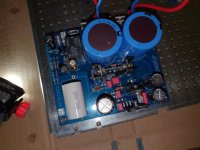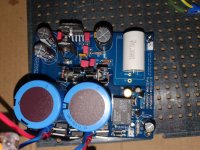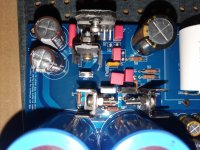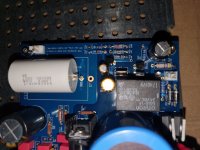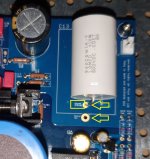I had a tube amplifier using a capacitance multiplier
Used a pair of Heathkit W-7M that had a capacitance multiplier power supply. That was a 1960’s tube amp with EL-34 tubes and 40 watts. Had a 550 volt B+.
It was class AB bias.
Some replaced the capacitance multiplier with a full wave rectifier for better regulation.
Used a pair of Heathkit W-7M that had a capacitance multiplier power supply. That was a 1960’s tube amp with EL-34 tubes and 40 watts. Had a 550 volt B+.
It was class AB bias.
Some replaced the capacitance multiplier with a full wave rectifier for better regulation.
So far the only certainty is that the Mundorf Supreme will no longer be one of the suggested caps.
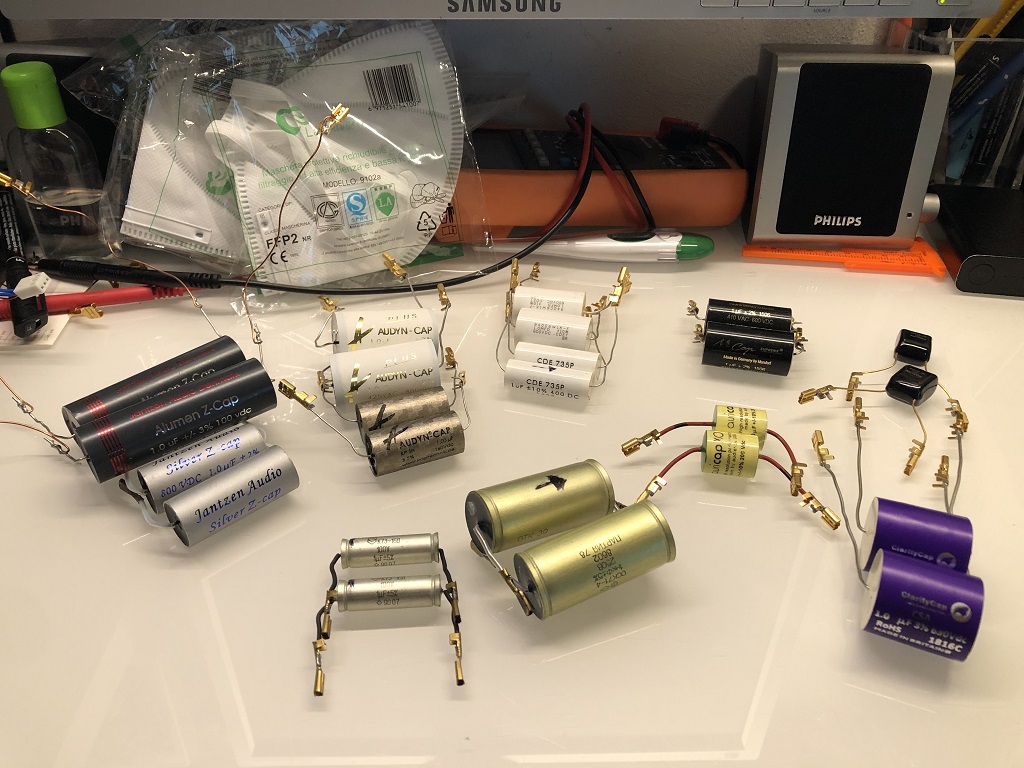
Hi Dario,
It is nice to see the K71-4 on the table. I hadn't considered it, but it might be interesting to see how they sound with the current BOM. I have always liked those caps.
Are the smaller Russian caps the K73-16? I would also like to hear your impression of those. As you know, I'm a fan of the K75-10 as long as you put a good bypass cap with it. The K75-10 is a hybrid of the PET in the K73-16 and paper in oil.
Your comment seems to suggest something negative about the Mundorf Supreme, or at least that they have been clearly surpassed. That is interesting because I went from Mundorf Silver Oil on my older boards to Mundorf Supreme on the jfet boards because the Silver Oil and other caps were less neutral than the Supreme with this particular BOM.
By the way, it is nice to have you back experimenting. You always come up with some interesting choices and I always learn something.
Last edited:
Hi Jac,
my system changed a lot from last BOM rehaul, now I have a much better DAC (Chord Qutest), better cables (Audioquest Big Sur from dac to pre and Mackenzie from pre to My_Ref), or so I thought... more later, a better vintage preamp (Harman/Karrdon HK825) and much better speakers (Monitor Audio Bronze 5).
This changes things.
They sound (much) bolder and bass heavy than the reference (DC coupling), the 940C in this regard is (way) better.
But this last comparison could have been affected by the Audioquest cables, it seems they have, to a lesser extent, the same problem...
How I discovered it?
I also have a Korg DS-DAC-10R (which is actually an ADC/DAC) that I've used to record some tracks from the Chord Qutest using several different cables I've had at home:
Guess what? The Audioquest were the worst, with the cheaper one (Golden Gate) better then the other two, at least regarding timbre.
Yes because Big Sur and Mackenzie have better detail retrivial and better harmonic and decay reproduction but Golden Gate timbre is pretty neutral on the contrary of the other two.Best cable? The Mogami, spot on timbre, harmonic content, decay, etc...
So in the next days I'll redo the comparison using the Mogami as interconnect.
Stay tuned.
my system changed a lot from last BOM rehaul, now I have a much better DAC (Chord Qutest), better cables (Audioquest Big Sur from dac to pre and Mackenzie from pre to My_Ref), or so I thought... more later, a better vintage preamp (Harman/Karrdon HK825) and much better speakers (Monitor Audio Bronze 5).
This changes things.
Not so good in the last comparison... they lacked harmonic content and accentuated transients with resulting hardness, sometimes and a smaller soundstage too.It is nice to see the K71-4 on the table. I hadn't considered it, but it might be interesting to see how they sound with the current BOM. I have always liked those caps.
The Supremes have a lot of good things, and taken in isolation sounds very good but they also have a timbre problem that bothered me since last BOM overhaul.Your comment seems to suggest something negative about the Mundorf Supreme, or at least that they have been clearly surpassed. That is interesting because I went from Mundorf Silver Oil on my older boards to Mundorf Supreme on the jfet boards because the Silver Oil and other caps were less neutral than the Supreme with this particular BOM.
They sound (much) bolder and bass heavy than the reference (DC coupling), the 940C in this regard is (way) better.
But this last comparison could have been affected by the Audioquest cables, it seems they have, to a lesser extent, the same problem...
How I discovered it?
I also have a Korg DS-DAC-10R (which is actually an ADC/DAC) that I've used to record some tracks from the Chord Qutest using several different cables I've had at home:
- Audioquest Big Sur
- Audioquest Mackenzie
- Audioquest Goldengate
- BlueJeans Cable (Belden1505F w/Canare RCAP true 75Ohm connectors)
- BlueJeans Cable (Belden1505F ROHS w/Canare RCAP true 75Ohm connectors)
- Mogami W2549 w/low mass AECO connectors
Guess what? The Audioquest were the worst, with the cheaper one (Golden Gate) better then the other two, at least regarding timbre.
Yes because Big Sur and Mackenzie have better detail retrivial and better harmonic and decay reproduction but Golden Gate timbre is pretty neutral on the contrary of the other two.Best cable? The Mogami, spot on timbre, harmonic content, decay, etc...
So in the next days I'll redo the comparison using the Mogami as interconnect.
Stay tuned.
https://www.diyaudio.com/forums/att...en-edition-build-thread-tutorial-img_0480-jpg
Hi Dario
How do you understand the direction of the segnal in a cup?
Have you never test mundor evo oil?I have the teac UD503 dac/pre and audioquest phanter dbs as rca cable
The mundorf evo oil sound very well ,smouth and fast like a good valve amplifier
Hi Dario
How do you understand the direction of the segnal in a cup?
Have you never test mundor evo oil?I have the teac UD503 dac/pre and audioquest phanter dbs as rca cable
The mundorf evo oil sound very well ,smouth and fast like a good valve amplifier
Last edited:
my system changed a lot from last BOM rehaul, now I have a much better DAC (Chord Qutest), better cables (Audioquest Big Sur from dac to pre and Mackenzie from pre to My_Ref), or so I thought... more later, a better vintage preamp (Harman/Karrdon HK825) and much better speakers (Monitor Audio Bronze 5).
This changes things.
The Supremes have a lot of good things, and taken in isolation sounds very good but they also have a timbre problem that bothered me since last BOM overhaul.
They sound (much) bolder and bass heavy than the reference (DC coupling), the 940C in this regard is (way) better.
But this last comparison could have been affected by the Audioquest cables, it seems they have, to a lesser extent, the same problem...
So in the next days I'll redo the comparison using the Mogami as interconnect.
Stay tuned.
Thanks Dario. I look forward to your results.
As you say, the system changes the choices we make. But then, that is why DIY is fun. We get to play with our own ideas and suggestions of others to decide what works best for us.
For example, the 940C sounds a little dull in my system, a touch soft on bass, and lacks dynamic punch. But it does seem quite linear and pretty neutral.
My system has changed over the years too. The pre-amp (DIY Reliaxed2) and speakers(DIY with old DynaAudio drivers) are the same, but I have gone NOS R2R dac in each system. My main system is a Metrum Pavane (used, I couldn't afford it new) and my office system, with the 4 channel FE's has a Metrum Onyx. I know for certain that the DACs have changed the sound and my choices.
I suppose I should include my analog and cables too. Analog is AR ES-1 turntable with am SME-3009 arm, Music Maker cartridge, and a DIY tube phono pre. Cables have remained the same, Mogami balanced cables for DAC to pre, phono pre to pre, and pre to FE, but my streamer (RPi3/Pi2AES) to DAC is i2s made from CAT5 cable.
We are having fun, aren't we?
Jac
Last edited:
You're welcomeThanks Dario. I look forward to your results.
Just now I'm comparing cables directly instead that via the recorded samples and results are consistent with record test but more obvious.
Absolutely.As you say, the system changes the choices we make. But then, that is why DIY is fun. We get to play with our own ideas and suggestions of others to decide what works best for us.
Interesting, my notes from last recent comparison about 940C:For example, the 940C sounds a little dull in my system, a touch soft on bass, and lacks dynamic punch. But it does seem quite linear and pretty neutral.
Excellent timbre, slightly closed sounding e less rich harmonic content, transients and details are good, excellent soundstage.
Not identical but pretty similar.
My system has changed over the years too. The pre-amp (DIY Reliaxed2) and speakers(DIY with old DynaAudio drivers) are the same, but I have gone NOS R2R dac in each system. My main system is a Metrum Pavane (used, I couldn't afford it new) and my office system, with the 4 channel FE's has a Metrum Onyx. I know for certain that the DACs have changed the sound and my choices.
I suppose I should include my analog path too. An AR ES-1 turntable with am SME-3009 arm, Music Maker cartridge, and a DIY tube phono pre.
We are having fun, aren't we?
Wow, your DACS looks stunning despite my adversion for NOS dacs!
Well, I should complete my setup description with analog too then: Technics SL-1610MK2 (working but to be restored) with AT VM540ML.
Wow, your DACS looks stunning despite my adversion for NOS dacs!
Yes, you and I did go down different roads with DACs. After all, some say the Chord filter is the longest and most detailed in the industry and the Metrum has no filter. But the good news is that you can arrive at good sound from different places. They may have different character, but both DACs have a good reputation.
Thank you for your PM. I will work on that.
Jac
Troubleshooting steps
Hi!
Just hooked up the amplifier to the transformer: relay clicks, led turns on, measured all voltages mentioned in the build guide. They are spot on.
Attach signal-in, generate a 1kHZ sin wave, attach a test speaker ... completely silent ...
What steps do you take for troubleshooting the circuit?
Thanks!
Hi!
Just hooked up the amplifier to the transformer: relay clicks, led turns on, measured all voltages mentioned in the build guide. They are spot on.
Attach signal-in, generate a 1kHZ sin wave, attach a test speaker ... completely silent ...
What steps do you take for troubleshooting the circuit?
Thanks!
Attachments
Just hooked up the amplifier to the transformer: relay clicks, led turns on, measured all voltages mentioned in the build guide. They are spot on.
Attach signal-in, generate a 1kHZ sin wave, attach a test speaker ... completely silent ...
What steps do you take for troubleshooting the circuit?
I would start from here:
Attachments
The right direction is related to the outer foil of the capacitor which goes toward the input connector.How do you understand the direction of the segnal in a cup?
Some caps, like Jantzen Alumen or Auricaps have markings for it, other have no markings at all but it is consistent with text direction and finally some are 'random'.
The only (somewhat) reliable method to determine is using an oscilloscope (see on you tube, you'll find plenty of videos) or directly on boards using fastons.
The onboard method is:
- Mount the cap and touch it, you will hear a (very) faint hum.
- Mount the cap the other way, touch it again and compare the resulting hum.
- When hum is less that is the right direction.
No, sincerely too costly and both the MCAP Zn and Supreme have that annoying bass coloration that always bothered me, I would not risk to spend so much money in a cap that probably has the same coloration.Have you never test mundor evo oil?I have the teac UD503 dac/pre and audioquest phanter dbs as rca cable
The mundorf evo oil sound very well ,smouth and fast like a good valve amplifier
In this moment during my evalution the Audin KP Sn seems the most transparent, detailed, rich and natural of the batch.
Clarity Cap CAS trades some detail and focus for musicality and larger than life soundstage, a good alternate for whom wants it coloured.
You're welcome.Oops ... thanks!!
Let us know if fixing it solves your problem.
Absolutely and while I'm convinced that NOS is an inherently flawed concept your DACs have state of the art discrete R2R implementation and output stage with a solid PS so I expect them to sound gorgeous... after all.Yes, you and I did go down different roads with DACs. After all, some say the Chord filter is the longest and most detailed in the industry and the Metrum has no filter. But the good news is that you can arrive at good sound from different places. They may have different character, but both DACs have a good reputation.
Digital filter (or its absence) is after all only a part of the DAC final performance.
You're welcome. Can't wait to read your impressions.Thank you for your PM. I will work on that.
Troubleshooting step 2
Good news, after resoldering C13 ... music is playing! However, it's a bit on the quiet side. I attached a small bookshelf speaker (Audioengine A2; 3.8 Ohms), normally attached to a built-in 15 W RMS amplifier. I can put my phone volume on max without it matching the built-in 15W RMS amplifier. I thought the LM3886 was rated at 68W RMS (4 ohm)?
Is this normal? Any measurements I could take?
Good news, after resoldering C13 ... music is playing! However, it's a bit on the quiet side. I attached a small bookshelf speaker (Audioengine A2; 3.8 Ohms), normally attached to a built-in 15 W RMS amplifier. I can put my phone volume on max without it matching the built-in 15W RMS amplifier. I thought the LM3886 was rated at 68W RMS (4 ohm)?
Is this normal? Any measurements I could take?
Try a passive speaker
Not sure how it is connected. Try a passive speaker to check output.
Good news, after resoldering C13 ... music is playing! However, it's a bit on the quiet side. I attached a small bookshelf speaker (Audioengine A2; 3.8 Ohms), normally attached to a built-in 15 W RMS amplifier. I can put my phone volume on max without it matching the built-in 15W RMS amplifier. I thought the LM3886 was rated at 68W RMS (4 ohm)?
Is this normal? Any measurements I could take?
Not sure how it is connected. Try a passive speaker to check output.
Not sure how it is connected. Try a passive speaker to check output.
The speakerpair consist of one speaker that contains the amplifier and one that is passive. I'm only using one speaker at the moment: the passive one.
Some observations
Any suggestions on how to systemically approach troubleshooting the board? Or any good guides on howto troubleshoot circuits? I don't have a background in electronics so I'm learning . Many thanks!
. Many thanks!
- Voltage difference between NAC1/NAC2 of 6,4 VAC RMS. Is that normal?
- With the speaker attached generating a 50Hz sine wave, I can measue a 1,1 Vac RMS over the speaker terminals and only 0,21 Aac RMS at maximum volume.
- When measuring the output terminals voltage difference I can measure 10.6 mV DC. Shorting the inputs does not have any impact on that measurement
Any suggestions on how to systemically approach troubleshooting the board? Or any good guides on howto troubleshoot circuits? I don't have a background in electronics so I'm learning
Some observations
- Voltage difference between NAC1/NAC2 of 6,4 VAC RMS. Is that normal?
- With the speaker attached generating a 50Hz sine wave, I can measue a 1,1 Vac RMS over the speaker terminals and only 0,21 Aac RMS at maximum volume.
- When measuring the output terminals voltage difference I can measure 10.6 mV DC. Shorting the inputs does not have any impact on that measurement
Any suggestions on how to systemically approach troubleshooting the board? Or any good guides on howto troubleshoot circuits? I don't have a background in electronics so I'm learning. Many thanks!
The relationship between output voltage and amperage sounds normal. Check polarity on input connection. Try bypassing C13.
If not this then gain is all fouled up. The limiter diodes could be reversed or shorted. Feedback values incorrect, or voltage to the LM318 too low
The other thing is that you really don't know the sensitivity of the passive speaker connection or the gain on the built-in amp. It is entirely possible that they designed it with a low sensitivity speaker and a high gain internal amp to compensate.
An example of that sort of thing was the Bose car speakers from the early 2000's. It was cheaper to make a 2 Ohm speaker and mount an amp on the back of it than it was to use a normal speaker and a standard output dash amp.
For what it is worth, most home speakers (85 to 90 dB/W) can be played just fine using an FE with a 10k or higher potentiometer on the input as a volume. The gain of the whole My_Ref series is 30 which is on the higher end of typical home amps.
Jac
An example of that sort of thing was the Bose car speakers from the early 2000's. It was cheaper to make a 2 Ohm speaker and mount an amp on the back of it than it was to use a normal speaker and a standard output dash amp.
For what it is worth, most home speakers (85 to 90 dB/W) can be played just fine using an FE with a 10k or higher potentiometer on the input as a volume. The gain of the whole My_Ref series is 30 which is on the higher end of typical home amps.
Jac
I would vote for input connection polarity as well...
Though.. I did not understand the line input AC value, too.. 6V AC?! Should be 24-25-26-27V AC RMS, even, depending on the transformer
And we did not hear about the DC voltages, as denominated on the backside on the board at the power supply section..
Though.. If the relay clicks, that is probably OK..
Then. It is on both boards or only one?
The feedback resistor values seem to be OK, as much as I can see..
And if it would be that low gain, because of an error there, it would be oscillating.. So probably not.
Try to generate a 100mV AC RMS, 370Hz signal on the input, and read the output, unloaded. Should be ~ 3,1V AC RMS.
370 is not a multiple of 50, and still low enough for the meter to be correctly revealed..
Ciao, George
Though.. I did not understand the line input AC value, too.. 6V AC?! Should be 24-25-26-27V AC RMS, even, depending on the transformer
And we did not hear about the DC voltages, as denominated on the backside on the board at the power supply section..
Though.. If the relay clicks, that is probably OK..
Then. It is on both boards or only one?
The feedback resistor values seem to be OK, as much as I can see..
And if it would be that low gain, because of an error there, it would be oscillating.. So probably not.
Try to generate a 100mV AC RMS, 370Hz signal on the input, and read the output, unloaded. Should be ~ 3,1V AC RMS.
370 is not a multiple of 50, and still low enough for the meter to be correctly revealed..
Ciao, George
Last edited:
- Home
- Amplifiers
- Chip Amps
- My_Ref Fremen Edition - Build thread and tutorial
